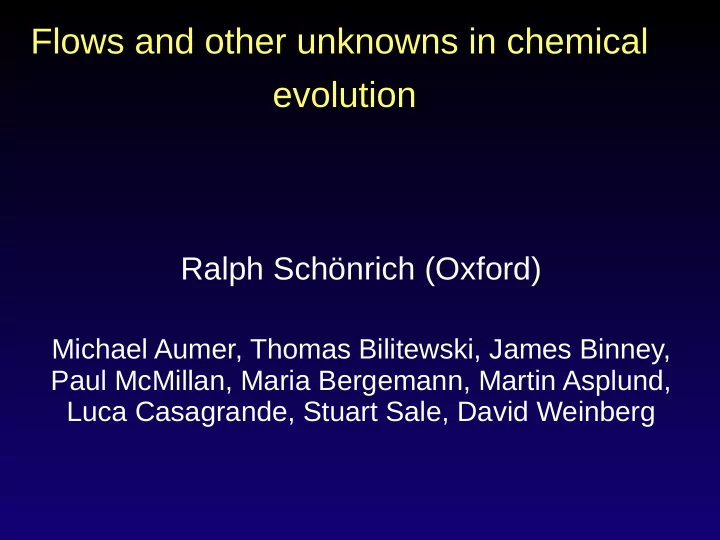

Flows and other unknowns in chemical evolution Ralph Schönrich (Oxford) Michael Aumer, Thomas Bilitewski, James Binney, Paul McMillan, Maria Bergemann, Martin Asplund, Luca Casagrande, Stuart Sale, David Weinberg
Questions - relatively steep radial metallicity profiles - inverse gradients - peculiar abundances of groups of stars
Analytic Disc Model outflow/loss ~ 50% of processed gas direct onflow ~ 75% of feed slightly pre-enriched Inflow ~ 25% of feed through disk Churning Blurring -mass exchange between neighbouring - implemented action rings conservation and improved -cold gas and stars kinematics -no heating of the disc - use Torus machine for -cf. Sellwood & Binney (2002) detailed kinematics
Chemical evolution vs. time SM 2017
The genesis of abundance gradients - non-saturation - F. Matteucci's models C. Chiappini et al., etc. - inside-out formation - metallicity dependent yields - radial flows Lacey & Fall (1985) - resonances Ang. mom. exchange - stellar asymmetric drift Ang. mom. conservation - inflow/onfall Goetz & Koeppen (1992), Portinari & Chiosi (2000), Spitoni & Matteucci (2011), also Pezzulli (2015)
Flows influence the gradient Onfall Luck (2011) Ang. Mom. dilution Inflow/metal advection Assume simple V law Bilitewski & Schönrich (2012)
The “average” onfall speed matters Bilitewski & Schönrich (2012)
Impact of SFH Bilitewski & Schönrich (2012)
Chemical evolution gas condensation warm cool evaporation inflow/onflow direct enrichment Fe-rich SNII+Ib,c a -rich IGM outflow SNIa stars progenitors
Short-lived isotopes in the early solar system Wasserburg et al. (2006)
Inverse radial gradients Cresci et al. (2010) Jones et al. (2010) Milky Way shows „flat“ gradients at high altitudes (see e.g. Cheng et al. 2012, Schlesinger et al. 2012)
Inverse gradients? Spagna et al. (2010)
Inverse gradients? Recent studies show an inverse relation between azimuthal velocity and metallicity for the thick disc, i.e. more metal-rich stars have faster az. velocity Spagna et al. (2010)
Inverse gradients? Lee et al. (2012) Inverse gradients in radius claimed for Lee et al. (2012) external galaxies (Cresci et al. 2010)
What's going on? Schoenrich & McMillan (2017)
Stellar profile S & M 2017
Or inverse gas metallicity profile by flows S & M 2017
Chemical evolution gas condensation warm cool evaporation inflow/onflow direct enrichment Fe-rich SNII+Ib,c a -rich IGM outflow SNIa stars progenitors
Young alpha-enriched stars Martig et al. (2015)
Young alpha-enriched stars Martig et al. (2015)
Summary - Only radial flows explain the observed metallicity gradient - Current abundance gradients from Cepheids are consistent with coronal gas accretion - Impact by resonances, “spiral“ inflow, viscosity? Onflow metallicity? - The radial dependence of onflow differs from expectations - Different gas phases can explain inverse metallicity profiles at early times - Inside-out formation inverts stellar metallicity profiles - Phase separation of yields will lead to abundance patterns, like relatively alpha enhanced young stars - Almost no theoretical predictions for the re-distribution of stellar yields yet - Affects stochastic chem. Evolution and chemical taggins
Giant Molecular Cloud impact Aumer, Binney & S (2016)
Central/nuclear disc
Inside-out? Bilitewski & Schönrich (2012)
Star formation efficiency? factor ~10
Impact of additional drag 0.2 km/s 0.4 km/s 0.6 km/s Bilitewski & Schönrich (2012)
Asymmetric drift probably negligible? Bilitewski & Schönrich (2012)
Asymmetric drift probably negligible Bilitewski & Schönrich (2012)
Good news: Churning and resolution unimportant Bilitewski & Schönrich (2012)
Where do galaxies get their gas from? Bilitewski & Schönrich (2012)
Onfall profile of Marinacci et al. does not reproduce gradient Bilitewski & Schönrich (2012)
Where do galaxies get their gas from? Bilitewski & Schönrich (2012)
Recommend
More recommend